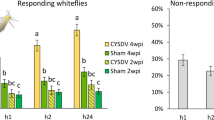Abstract
Induced defenses mediate interactions between parasites sharing the same host plant, but the outcomes of these interactions are challenging to predict because of spatiotemporal variation in plant responses and differences in defense pathways elicited by herbivores or pathogens. Dissecting these mediating factors necessitates an approach that encompasses a diversity of parasitic feeding styles and tracks interactions over space and time. We tested indirect plant-mediated relationships across three tomato (Solanum lycopersicum) consumers: (1) the fungal pathogen—powdery mildew, Oidium neolycopersici; (2) a sap-feeding insect—silverleaf whitefly, Bemisia tabaci; and (3) a chewing insect—the leaf miner, Tuta absoluta. Further, we evaluated insect/pathogen responses on local vs. systemic leaves and over short (1 day) vs. long (4 days) time scales. Overall, we documented: (1) a bi-directional negative effect between O. neolycopersici and B. tabaci; (2) an asymmetrical negative effect of B. tabaci on T. absoluta; and (3) an asymmetrical positive effect of T. absoluta on O. neolycopersici. Spatiotemporal patterns varied depending on the species pair (e.g., whitefly effects on leaf miner performance were highly localized to the induced leaf, whereas effects on pathogen growth were both local and systemic). These results highlight the context-dependent effects of induced defenses on a diverse community of tomato parasites. Notably, the outcomes correspond to those predicted by phytohormonal theory based on feeding guild differences with key implications for the recent European invasion by T. absoluta.







Similar content being viewed by others
References
Blackmer JL, Byrne DN (1999) The effect of Bemisia tabaci on amino acid balance in Cucumis melo. Entomol Exp Appl 93:315–319
Bompard A, Jaworski C, Bearez P, Desneux N (2013). Sharing a predator: can an invasive alien pest affect the predation on a local pest? Popul Ecol 55:433–440
Bostock RM (1999) Signal conflicts and synergies in induced resistance to multiple attackers. Physiol Mol Plant Path 55:99–109
Brown JK, Frohlich DR, Rosell RC (1995) The sweet potato or silverleaf whiteflies: biotypes of Bemisia tabaci or a species complex? Annu Rev Entomol 40:511–534
Cagnotti CL, Viscarret MM, Riquelme MB, Botto EN, Carabajal LZ, Segura DF, Lopez SN (2012) Effects of X-rays on Tuta absoluta for use in inherited sterility programmes. J Pest Sci 85:413–421
Campos ML, De Almeida M, Rossi ML, Martinelli AP, Junior CGL, Figueira A, Rampelotti-Ferreira FT, Vendramim JD, Benedito VA, Peres LEP (2009) Brassinosteroids interact negatively with jasmonates in the formation of anti-herbivory traits in tomato. J Exp Bot 60:4347–4361
Cooper WR, Goggin FL (2005) Effects of jasmonate-induced defenses in tomato on the potato aphid, Macrosiphum euphorbiae. Entomol Exp Appl 115:107–115
Desneux N, O’Neil RJ (2008) Potential of an alternative prey to disrupt predation of the generalist predator, Orius insidiosus, on the pest aphid, Aphis glycines, via short-term indirect interactions. B Entomol Res 98:631–639
Desneux N, Wajnberg E, Wyckhuys KAG, Burgio G, Arpaia S, Narváez-Vasquez CA, González-Cabrera J, Catalán Ruescas D, Tabone E, Frandon J et al (2010) Biological invasion of European tomato crops by Tuta absoluta: ecology, geographic expansion and prospects for biological control. J Pest Sci 83:197–215
Desneux N, Luna MG, Guillemaud T, Urbaneja A (2011) The invasive South American tomato pinworm, Tuta absoluta, continues to spread in Afro-Eurasia and beyond–the new threat to tomato world production. J Pest Sci 84:403–408
Erb M, Meldau S, Howe GA (2012) Role of phytohormones in insect-specific plant reactions. Trends Plant Sci 17:250–259
Glazebrook J (2005) Contrasting mechanisms of defense against biotrophic and necrotrophic pathogens. Annu Rev Phytopathol 43:205–227
Goggin FL (2007) Plant-aphid interactions: molecular and ecological perspectives. Curr Opin Plant Biol 10:399–408
Howe GA, Jander G (2008) Plant immunity to insect herbivores. Annu Rev Plant Biol 59:41–66
Inbar M, Doostdar H, Sonoda RM, Leibee GL, Mayer RT (1998) Elicitors of plant defensive systems reduce insect densities and disease incidence. J Chem Ecol 24:135–149
Inbar M, Doostdar H, Leibee GL, Mayer RT (1999) The role of plant rapidly induced responses in asymmetric interspecific interactions among insect herbivores. J Chem Ecol 25:1961–1979
Inbar M, Gerling D (2008) Plant-mediated interactions between whiteflies, herbivores, and natural enemies. Annu Rev Entomol 53:431–448
Jiao XG, Xie W, Wang SL, Wu QJ, Zhou L, Pan HP, Liu BM, Zhang YJ (2012) Host preference and nymph performance of B and Q putative species of Bemisia tabaci on three host plants. J Pest Sci 85:423–430
Jones H, Whipps JM, Gurr SJ (2001) The tomato powdery mildew fungus Oidium neolycopersici. Mol Plant Pathol 2:303–309
Kaloshian I, Walling LL (2005) Hemipterans as plant pathogens. Annu Rev Phytopathol 43:491–521
Kaplan I, Denno RF (2007) Interspecific interactions in phytophagous insects revisited: a quantitative assessment of competition theory. Ecol Lett 10:977–994
Kaplan I, Thaler JS (2012) Phytohormone-mediated plant resistance and predation risk act independently on the population growth and wing formation of potato aphids, Macrosiphum euphorbiae. Arthropod Plant Interact 6:181–186
Kaplan I, Halitschke R, Kessler A, Sardanelli S, Denno RF (2008) Physiological integration of roots and shoots in plant defense strategies links above- and belowground herbivory. Ecol Lett 11:841–851
Karban R, Baldwin IT (1997) Induced responses to herbivory. University of Chicago Press, Chicago
Kawazu K, Mochizuki A, Yukie S, Sugeno W, Murata M, Seo S, Mitsuhara I (2012) Different expression profiles of jasmonic acid and salicylic acid inducible genes in the tomato plant against herbivores with various feeding modes. Arthropod Plant Interact 6:221–230
Kempema LA, Cui X, Holzer FM, Walling LL (2007) Arabidopsis transcriptome changes in response to phloem-feeding silverleaf whitefly nymphs: similarities and distinctions in responses to aphids. Plant Physiol 143:849–865
Kessler A, Baldwin IT (2002) Plant responses to insect herbivory: the emerging molecular analysis. Annu Rev Plant Biol 53:299–328
Kessler A, Halitschke R (2007) Specificity and complexity: the impact of herbivore-induced plant responses on arthropod community structure. Curr Opin Plant Biol 10:409–414
Li C, Bai Y, Jacobsen E, Visser R, Lindhout P, Bonnema G (2006) Tomato defense to the powdery mildew fungus: differences in expression of genes in susceptible, monogenic- and polygenic resistance responses are mainly in timing. Plant Mol Biol 62:127–140
Lynch ME, Kaplan I, Dively GP, Denno RF (2006) Host-plant-mediated competition via induced resistance: interactions between pest herbivores on potatoes. Ecol Appl 16:855–864
Mayer RT, Inbar M, McKenzie CL, Shatters R, Borowicz V, Albrecht U, Powell CA, Doostdar H (2002) Multitrophic interactions of the silverleaf whitefly, host plants, competing herbivores, and phytopathogens. Arch Insect Biochem 51:151–169
Mouttet R, Bearez P, Thomas C, Desneux N (2011) Phytophagous arthropods and a pathogen sharing a host plant: evidence for indirect plant-mediated interactions. PLoS One 6:e18840
Ohgushi T (2005) Indirect interaction webs: herbivore-induced effects through trait change in plants. Annu Rev Ecol Evol S 36:81–105
Ohgushi T (2008) Herbivore-induced indirect interaction webs on terrestrial plants: the importance of non-trophic, indirect, and facilitative interactions. Entomol Exp Appl 128:217–229
Orians CM (2005) Herbivores, vascular pathways, and systemic induction: facts and artifacts. J Chem Ecol 31:2231–2242
Orians CM, Pomerleau J, Ricco R (2000) Vascular architecture generates fine scale variation in systemic induction of proteinase inhibitors in tomato. J Chem Ecol 26:471–485
Parrella G, Scassillo L, Giorgini M (2012) Evidence for a new genetic variant in the Bemisia tabaci species complex and the prevalence of the biotype Q in southern Italy. J Pest Sci 85:227–238
Paul ND, Hatcher PE, Taylor JE (2000) Coping with multiple enemies: an integration of molecular and ecological perspectives. Trends Plant Sci 5:220–225
Poelman EH, Broekgaarden C, Van Loon JJA, Dicke M (2008) Early season herbivore differentially affects plant defence responses to subsequently colonizing herbivores and their abundance in the field. Mol Ecol 17:3352–3365
Puthoff DP, Holzer FM, Perring TM, Walling LL (2010) Tomato pathogenesis-related protein genes are expressed in response to Trialeurodes vaporariorum and Bemisia tabaci biotype B feeding. J Chem Ecol 36:1271–1285
Ramirez-Romero R, Desneux N, Chaufaux J, Kaiser L (2008) Bt-maize effects on biological parameters of the non-target aphid Sitobion avenae (Homoptera: Aphididae) and Cry1Ab toxin detection. Pestic Biochem Phys 91:110–115
Rodriguez-Saona C, Chalmers JA, Raj S, Thaler JS (2005) Induced plant responses to multiple damagers: differential effects on an herbivore and its parasitoid. Oecologia 143:566–577
Rodriguez-Saona CR, Rodriguez-Saona LE, Frost CJ (2009) Herbivore-induced volatiles in the perennial shrub, Vaccinium corymbosum, and their role in inter-branch signaling. J Chem Ecol 35:163–175
Soler R, Van der Putten WH, Harvey JA, Vet LEM, Dicke M, Bezemer TM (2012a) Root herbivore effects on aboveground multitrophic interactions: patterns, processes and mechanisms. J Chem Ecol 38:755–767
Soler R, Badenes-Pérez FR, Broekgaarden C, Zheng SJ, David A, Boland W, Dicke M (2012b) Plant-mediated facilitation between a leaf-feeding and a phloem-feeding insect in a brassicaceous plant: from insect performance to gene transcription. Funct Ecol 26:156–166
Soler R, Erb M, Kaplan I (2013) Long distance root–shoot signalling in plant–insect community interactions. Trends Plant Sci 18:149–156
Stout MJ, Workman KV, Duffey SS (1996a) Identity, spatial distribution, and variability of induced chemical responses in tomato plants. Entomol Exp Appl 79:255–271
Stout MJ, Workman KV, Workman JS, Duffey SS (1996b) Temporal and ontogenetic aspects of protein induction in foliage of the tomato, Lycopersicon esculentum. Biochem Syst Ecol 24:611–625
Stout MJ, Thaler JS, Thomma BPHJ (2006) Plant-mediated interactions between pathogenic microorganisms and herbivorous arthropods. Annu Rev Entomol 51:663–689
Tack AJM, Gripenberg S, Roslin T (2012) Cross-kingdom interactions matter: fungal-mediated interactions structure an insect community on oak. Ecol Lett 15:177–185
Thaler JS, Fidantsef AL, Duffey SS, Bostock RM (1999) Trade-offs in plant defense against pathogens and herbivores: a field demonstration of chemical elicitors of induced resistance. J Chem Ecol 25:1597–1609
Thaler JS, Fidantsef AL, Bostock RM (2002) Antagonism between jasmonate- and salicylate- mediated induced plant resistance: effects of concentration and timing of elicitation on defense-related proteins, herbivore, and pathogen performance in tomato. J Chem Ecol 28:1131–1159
Thaler JS, Agrawal AA, Halitschke R (2010) Salicylate-mediated interactions between pathogens and herbivores. Ecology 91:1075–1082
Van Zandt PA, Agrawal AA (2004) Community-wide impacts of herbivore-induced plant responses in milkweed (Asclepias syriaca). Ecology 85:2616–2629
Viswanathan DV, Narwani AJT, Thaler JS (2005) Specificity in induced plant responses shapes patterns of herbivore occurrence on Solanum dulcamara. Ecology 86:886–896
Walling LL (2000) The myriad plant responses to herbivores. J Plant Growth Reg 19:195–216
Zarate SI, Kempema LA, Walling LL (2007) Silverleaf whitefly induces salicylic acid defenses and suppresses effectual jasmonic acid defenses. Plant Physiol 143:866–875
Zhang LP, Zhang GY, Zhang YJ, Zhang WJ, Liu Z (2005) Interspecific interactions between Bemisia tabaci (Hem., Aleyrodidae) and Liriomyza sativae (Dipt., Agromyzidae). J Appl Entom 129:443–446
Zhang PJ, Zheng SJ, van Loon JJA, Boland W, David A, Mumm R, Dicke M (2009) Whiteflies interfere with indirect plant defense against spider mites in Lima bean. Proc Natl Acad Sci (USA) 106:21202–21207
Acknowledgments
The authors declare that they have no conflict of interest and that all experiments were conducted in compliance with US law. We thank the editor (Roland Brandl), two anonymous reviewers for helpful comments on an earlier version of this manuscript, and Hélène Kazuro for assistance throughout the experiments. This work was supported by funds from the Environment and Agronomy department of INRA and from the French ministry of agriculture (CASDAR 10063) to ND.
Author information
Authors and Affiliations
Corresponding author
Additional information
Communicated by Roland Brandl.
Rights and permissions
About this article
Cite this article
Mouttet, R., Kaplan, I., Bearez, P. et al. Spatiotemporal patterns of induced resistance and susceptibility linking diverse plant parasites. Oecologia 173, 1379–1386 (2013). https://doi.org/10.1007/s00442-013-2716-6
Received:
Accepted:
Published:
Issue Date:
DOI: https://doi.org/10.1007/s00442-013-2716-6




